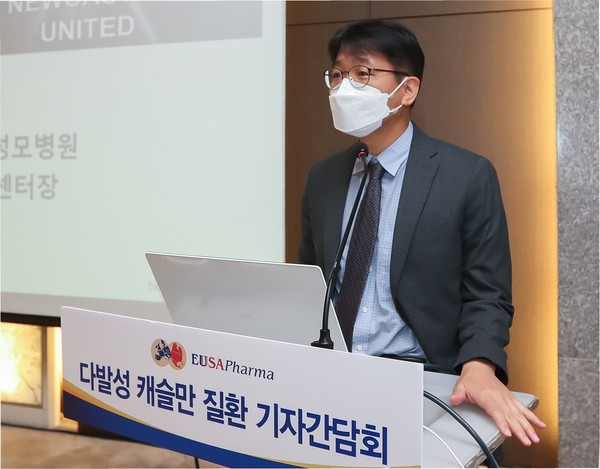Multicentric Castleman disease (MCD) is not cancer, but its prognosis is as poor as cancer.
MCD is so rare and difficult to diagnose. As a result, many MCD patients get misdiagnosis and miss the right timing for treatment.

Professor Jeon Young-woo of hematology at Yeouido St. Mary’s Hospital emphasized the need to raise awareness of MCD at a press conference on Wednesday held by EUSA Pharma in celebration of World Castleman Disease Day which falls on July 23.
Every year, 6,500-7,700 Americans are newly diagnosed with Castleman disease. Among them, about 1,650 are MCD patients.
MCD is a blood disease in the pre-lymphoma stage, and the main cause of the onset is overexpression of interleukin-6. In MCD patients, the liver or spleen where lymph nodes or lymphoid tissues are located can be enlarged because of the excessive proliferation of lymphocytes. MCD can occur anywhere in the body where lymph nodes are.
Jeon said the pathogenesis of Castleman disease has three hypotheses – a primary reaction to an autoimmune disease, a secondary change associated with cancer, and immune response to a viral infection. He explained that when an inflammation environment is created for these various reasons, inflammatory cytokines are overactivated, and lymph nodes are enlarged in a vicious cycle.
MCD’s prognosis is as poor as that of cancer. A study showed that about 27 percent of MCD patients get diagnosed with cancer within two to five years after the MCD diagnosis. In addition, about 35 percent of idiopathic MCD patients die within five years after diagnosis.
The problem is that it takes much time to get the MCD diagnosis. “In Korea, it takes about four years between the onset of symptoms and diagnosis,” Jeon said.
As MCD’s symptoms are fatigue, fever, weight loss, and night sweats, it is difficult to suspect Castleman disease only with these symptoms, he said.
Usually, close collaboration between the pathology department and the hematology department is crucial to diagnosing MCD. Typical symptoms include chronic systemic fatigue that makes it impossible to carry a normal life. Other symptoms include night sweats, chills, fever, headache, flu, weight loss, joint pain, systemic edema, skin changes, and neuropathy.
Patients often go through two or three departments, such as internal medicine, rheumatology, and neurology, and eventually receive an MCD diagnosis in hematology.
The hematology department also considers MCD diagnosis if the pathology department suspects it.
Usually, the pathology department suspects lymphoma after a test. If it’s not lymphoma, MCD is suspected.
Jeon stressed that a quick and accurate diagnosis of MCD can give hope to patients.
Unlike other rare diseases, MCD has the first-line standard care guideline established by Castleman Disease Collaborative Network (CDCN) in 2018.
In Korea, the government granted health insurance benefits for MCD treatments in February 2018. Thus, local MCD patients have a relatively good treatment environment.
“If patients can get timely treatment, they can return to their daily lives as soon as possible with a good prognosis,” Jeon added.
He went on to say that educating the general public and the medical community about this rare disease was urgent.
“It will be important to raise the awareness among doctors at clinic whom patients seek first and to make quick judgments about the suspicion of Castleman disease in secondary hospitals. This will reduce the delay in diagnosis and prevent worsening symptoms,” he said.

